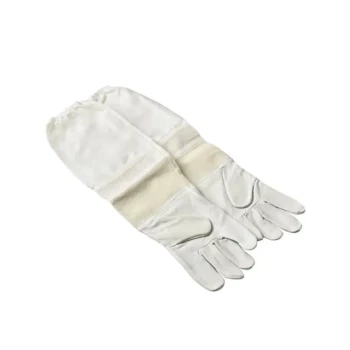At its core, beekeepers wear gloves for two fundamental reasons: to protect their hands from painful bee stings and to provide a barrier against the sticky substances found within a hive. This protection is not just about comfort; it ensures the beekeeper can remain calm and focused, handling the bees gently and effectively without fear of injury.
While a bee sting is always unpleasant, a sting on the hand can be uniquely debilitating. Gloves are therefore a critical tool for managing risk, preserving hand function, and enabling the beekeeper to work with confidence.
The Primary Role: Mitigating Stings
The most immediate reason for wearing gloves is to prevent bee stings. While bees are not typically aggressive, they will defend their colony, especially during a hive inspection.
Why Hand Stings Are a Unique Problem
Stings on the hands and fingers are often more painful and can cause significant swelling. This can impair fine motor skills and reduce hand mobility, making it difficult to perform the delicate tasks required for beekeeping or even to carry on with daily activities after leaving the apiary.
Your hands are your most important tools, and protecting their function is paramount.
Building Confidence for Safer Handling
For new beekeepers, the fear of being stung can lead to jerky, uncertain movements, which can agitate the bees and make stings more likely. Gloves provide a crucial layer of mental armor.
This peace of mind allows the beekeeper to move deliberately and calmly, fostering a better understanding of bee behavior and promoting safer handling practices for both the keeper and the colony.
Beyond Stings: The Practical Benefits
While sting prevention is the main driver, gloves offer several other practical advantages that contribute to good hive management.
Maintaining Hygiene and Control
Beehives contain sticky substances like honey and propolis (a resinous "bee glue"). Gloves keep your hands clean, preventing you from becoming a sticky mess and allowing you to maintain a secure grip on your tools and hive components.
Preventing the Spread of Disease
Gloves are also an important tool for biosecurity. By cleaning your gloves or switching to a fresh pair when moving between different hives, you can help prevent the accidental transfer of pests or diseases throughout your apiary.
Understanding the Trade-offs
The decision to wear gloves is not without nuance. While strongly recommended for most, it's helpful to understand the complete picture.
The Argument for Going Gloveless
Some highly experienced beekeepers occasionally work with their bare hands, especially when handling a colony they know to be exceptionally gentle. They argue this provides greater dexterity and a better "feel" for the hive frames, reducing the risk of accidentally crushing bees.
The Inherent Risks of Forgoing Protection
Working without gloves is a choice that should only be made from a position of deep experience. The risk of stings, and the potential for an unexpected allergic reaction, is always present.
For beginners, or when working with a new or aggressive colony, the benefits of wearing gloves far outweigh any perceived loss of dexterity. The primary goal is always safety.
Making the Right Choice for Your Goal
Protective gear allows you to focus on the health of your colony. The right choice depends on your experience level and goals.
- If your primary focus is learning and safety: Always wear gloves. This will allow you to build confidence and learn proper handling techniques without the constant fear of being stung.
- If your primary focus is managing multiple hives: Treat your gloves as a biosecurity tool. Ensure they are clean between hive inspections to protect the health of all your colonies.
- If your primary focus is maximum dexterity with a familiar, calm hive: As an expert, you might choose to work gloveless, but you must always have protective gear on hand in case the bees' temperament changes unexpectedly.
Ultimately, protective equipment empowers you to be a better, more attentive, and more effective beekeeper.
Summary Table:
| Key Reason | Primary Benefit |
|---|---|
| Sting Protection | Prevents painful stings that can impair hand function and confidence. |
| Hygiene & Grip | Keeps hands clean from sticky honey and propolis for better tool control. |
| Disease Prevention | Acts as a biosecurity barrier to stop the spread of pests between hives. |
Equip your apiary with professional-grade protection from HONESTBEE.
Whether you manage a commercial apiary or distribute beekeeping equipment, having the right gear is fundamental to safety and efficiency. HONESTBEE supplies durable, high-quality beekeeping gloves and equipment designed for the demands of professional beekeeping.
Contact our wholesale team today to discuss your needs and discover how our supplies can help your operation work safer and smarter.
Related Products
- Beekeeping Gloves Goatskin Leather with Long Cotton Sleeve for Beekeepers
- Goatskin Leather Beekeeper Gloves with Vent Long Sleeve for Beekeeping Honey Bee Sting Proof Protection
- Goat Skin Leather Bee Sting Proof Beekeeping Gloves with Canvas Sleeve
- Mesh Ventilated 3 Layer Goatskin Beekeepers Gloves for Beekeeping
- Professional Galvanized Hive Strap with Secure Locking Buckle for Beekeeping
People Also Ask
- How often should beekeeping gloves be cleaned? Extend Their Lifespan & Protect Your Hands
- Why is regular cleaning important for beekeeping gloves? Protect Your Hives & Safety
- Can household cleaning products be used on beekeeping gloves? Protect Your Gloves and Your Hive
- How can I freshen up beekeeping gloves? A Step-by-Step Guide to Proper Cleaning & Maintenance
- What are the features of beekeeping gloves? Balancing Protection & Dexterity for Your Hives



















